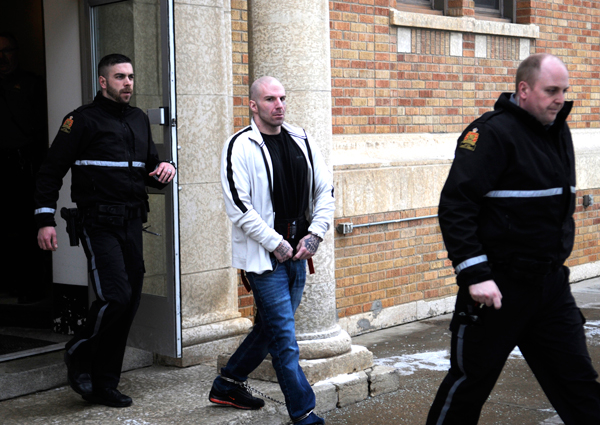
Warning, graphic content
Christopher Van Camp was alive for “minutes, not hours,” after he was attacked between June 6 and 7, 2017 court heard Friday as Forensic Pathologist Dr. Shaun Ladham took the stand.
Van Camp was found dead in his Saskatchewan Penitentiary cell with multiple wounds to his face and body just hours after returning to the institution after overdosing while on parole. His cellmate at the time, Tyler Vandewater, is on trial for second-degree murder in his death.
Van Camp’s mother, Lauren Laithwaite, cried as Ladham went through grisly images of the many cuts, stabs and scrapes he found on the victim’s face, head, neck, chest and shoulder.
Ladham said there were 26 wounds to Van Camp’s face and head area ranging in length from 5.6 cm to just a few millimetres. Wounds were found on the forehead and both cheeks. Van Camp’s eyelid was split in two.
Ladham said he couldn’t tell if some of the wounds were from a blunt force such as someone striking the head hard, or whether they were made by shallow cuts from a dull blade that would tear, rather than cut.
He also said that there were a handful of fractures to Van Camp’s face, but none to his skull.
The wounds continued down Van Camp’s face to his neck and across his chest. There were only four wounds on his chest. Three of them had hit his lungs, with two of those going right through and into his heart.
The wounds to Van Camp’s face and body would have resulted in significant bleeding, Ladham said.
Blood was found in Van Camp’s chest cavity, as well as behind his heart.
Several injuries were also seen on Van Camp’s back, with 25 stab wounds found near the top half of his back. One small puncture was found on his shoulder and a small slice on his right index finger.
As stated in the agreed statement of facts, Ladham confirmed that Van Camp died from blood loss and from a collapsed lung.
Indeed, the collapsed lung itself could have been a lethal injury, the pathologist said, as x-rays showed the airway had been pushed to the side. The pressure involved in such a lung deflation could push on blood vessels and restrict the other lung’s ability to function.
Ladham said there was “hardly any blood left” in the heart, a sign Van Camp had suffered “excessive blood loss: and “significant bleeding.”
However, Ladham couldn’t tell if there was one fatal stab wound or in what order the injuries occurred.
The majority of the wounds wouldn’t have required much force themselves, he said, though the broken bones in Van Camp’s face required “increasing force.”
Ladham was presented with two weapons found at the scene — a small, straight sharpened metal spike and a homemade knife with a cloth handle.
The small spike, court heard earlier in the week, resembled a fence tie. It was found resting on the bed beside Van Camp.
The injuries to Van Camp’s chest and back “look like” they could have been made from that weapon, while the longer slashes Van Camp took to his face could have been made by something resembling the homemade knife.
A bloodied pen was also found on scene, and while it could have made some of the wounds, Ladham said it was “unlikely” that it would have been able to be used for some of the deeper blows, such as the ones that pierced the heart.
A forensic report showed that blood found on all three implements came from Van Camp.
“If all this occurred very rapidly,… it’s going to be minutes, not hours,” before Van Camp died, Ladham testified.
He was unsure whether Van Camp lost consciousness. While there were some signs of head injuries, Van Camp didn’t live long enough for them to spread and show signs of brain damage, Ladham said.
He also didn’t spot any defensive or offensive wounds.
He also testified about rigor mortis.
Nurse Dinah Willoughby testified on Wednesday that rigor mortis had already set in by the time she arrived on the scene shortly after 8 a.m.
Ladham said that muscles have the energy to drive them, and in normal conditions, two to three hours after death, they begin to become stiff. However, he said, if a seizure occurred, rigor mortis could set in much more quickly.
On Cross-Examination, Defence lawyer Brian Pfefferle used Ladham’s background as a doctor to question him on some of the details of Van Camp’s medical report.
That report had been from Van Camp’s overdose about two weeks prior to his return to Saskatchewan Penitentiary.
He had low oxygen levels and multiple drugs in his system when he was admitted to the hospital.
In response to questions from Pfefferle and from Justice B. Scherman, Ladham said that while such conditions could cause brain damage, there was none in the neurologist’s report from after Van Camp’s death.
He said it was unclear if Van Camp was subject to any psychological testing following his hospitalization.
Following Ladham’s testimony, the Crown closed its case.

